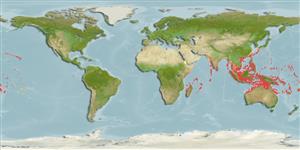Environment: milieu / climate zone / depth range / distribution range
Οικολογία
Θαλασσινό(ά); Γλυκού νερού; Υφάλμυρο Υφαλόφιλο(α); εύρος βάθους 1 - 50 m (Ref. 57343), usually 20 - 50 m (Ref. 9685). Tropical; 34°N - 23°S, 50°E - 148°W (Ref. 57343)
Indo-Pacific: mainly around oceanic islands. Known from Mauritius, Seychelles, Kenya and many islands of the northern Indian Ocean; then from Indonesia north to the Ryukyu, Ogasawara and Yaeyama islands and east to the Hawaiian Islands, French Polynesia and Pitcairn. Has not been collected in Australia (Ref. 57343).
Μέγεθος / Βάρος / Age
Maturity: Lm ? range ? - ? cm
Max length : 61.0 cm TL αρσενικό/απροσδιόριστο; (Ref. 4887); μεγ. δημοσιευμένο βάρος: 3.2 kg (Ref. 4699)
Ραχιαίες άκανθες (συνολικά): 9; Μαλακές ραχιαίες ακτίνες (συνολικά): 13; Εδρικές άκανθες 3; Μαλακές εδρικές ακτίνες: 11. Body uniformly golden silver; occasionally with several faint dark stripes along longitudinal scale rows above and below lateral line. Pectoral filaments 6 with tip of uppermost filament reaching to or slightly beyond level of posterior tip of upper part of pectoral fin (Ref. 41110).
This schooling species occurs along sandy and rocky shorelines and over sandy lagoon bottoms, often in zones of turbulence (Ref. 9685). Benthopelagic (Ref. 58302). Often encountered in river mouths or brackish mangrove estuaries. Feeds mainly on crustaceans (shrimps and crabs), polychaete worms, other benthic invertebrates; also on teleosts (Ref. 9685). A lunar spawning rhythm occurs close to shore (Ref. 9685). Sexual maturity in males occurs at 12 to 15 cm (Ref. 9685). Subsequently undergoes sex reversal passing through a hermaphroditic stage, and become female between 18 and 24 cm (Ref. 9685). The potential of this species for aquaculture has been studied (Ref. 9685).
Life cycle and mating behavior
Γεννητική Ωρίμανση | Αναπαραγωγή | Γεννοβολία | Αβγά | Γονιμότητα | Προνύμφες
Motomura, H., 2004. Threadfins of the world (Family Polynemidae). An annotated and illustrated catalogue of polynemid species known to date. FAO Spec. Cat. Fish. Purp. Rome: FAO. 3:117 p. (Ref. 57343)
IUCN Red List Status (Ref. 130435)
Threat to humans
Harmless
Human uses
αλιεία: Εμπορικό(ά); Υδατοκαλλιέργειες: πειραματικό; αλιεία αναψυχής: ναί; Ενυδρείο: Εμπορικό(ά)
Περισσότερες πληροφορίες
Κοινά ονόματαΣυνώνυμαΜεταβολισμόςΘηρευτέςΟικοτοξικολογίαΑναπαραγωγήΓεννητική ΩρίμανσηΓεννοβολίαΣυναθροίσεις γεννοβολίαςΓονιμότηταΑβγάEgg development
ΑναφορέςΥδατοκαλλιέργειεςΠροφίλ υδατοκαλλιέργειαςΣτελέχοιΓενετικήElectrophoresesΚληρονομικότηταΑσθένειεςΜεταποίησηNutrientsMass conversion
ΣυνεργάτεςΦωτογραφίεςStamps, Coins Misc.ΉχοιΣιγκουατέραΤαχύτηταΚολυμβητικός ΤύποςΕπιφάνεια βραγχίωνOtolithsΕγκέφαλοιΌραση
Εργαλεία
Special reports
Download XML
Διαδικτυακές πηγές
Estimates based on models
Preferred temperature (Ref.
123201): 24.1 - 29, mean 27.9 °C (based on 1038 cells).
Phylogenetic diversity index (Ref.
82804): PD
50 = 0.5000 [Uniqueness, from 0.5 = low to 2.0 = high].
Bayesian length-weight: a=0.01820 (0.01045 - 0.03170), b=3.11 (2.96 - 3.26), in cm total length, based on LWR estimates for this species & (Sub)family-body (Ref.
93245).
Τροφικό Επίπεδο (Ref.
69278): 3.4 ±0.49 se; based on food items.
Ελαστικότητα (Ref.
120179): Μεσαίο(α), ελάχιστος χρόνος για διπλασιασμό πληθυσμού 1,4 - 4,4 έτη (Preliminary K or Fecundity.).
Fishing Vulnerability (Ref.
59153): Moderate vulnerability (44 of 100).
Nutrients (Ref.
124155): Calcium = 38.5 [16.0, 64.6] mg/100g; Iron = 0.484 [0.247, 0.933] mg/100g; Protein = 19.8 [18.0, 21.6] %; Omega3 = 0.111 [0.072, 0.175] g/100g; Selenium = 37.4 [19.5, 80.0] μg/100g; VitaminA = 31.6 [8.9, 109.8] μg/100g; Zinc = 1.02 [0.68, 1.55] mg/100g (wet weight);
